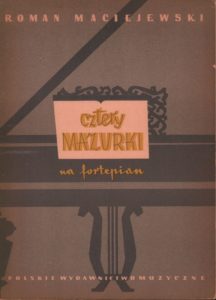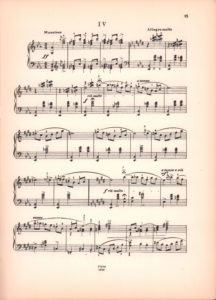Maciejewski is one of the hopes of young Polish music […]. The Mazurkas have given Maciejewski an opportunity to reveal his temperament and feel for sound, for luscious sound, both when it comes to harmony and piano texture.
[J. Freiheiter, “Roman Maciejewski. Sprawozdania. Z współczesnej literatury polskiej”, Muzyka Polska 1935 no. 6, p. 139.]
This is an excerpt of a 1932 review of the first four published Mazurkas by the composer, who was barely twenty-two at the time. As a result of such opinions, which kept coming in great numbers, Maciejewski became known among both music critics and performers as a talented composer while he was still a student at the Warsaw Conservatoire. The Mazurkas are a kind of a leitmotif in Maciejewski’s compositional activity, a magnificent development of the Chopin idiom as well as a very original proposal to continue the national-folkloristic strand in Polish music. But why a leitmotif? In addition to the four youthful miniatures, the composer kept coming back to the mazurkas almost throughout his life, as a result of which:
- 13 more pieces were written around 1948 in Sweden (although Maciejewski may have written two of them in the United Kingdom);
- two Mazurkas were composed in 1952 (Los Angeles and Maciejewski’s visit to Rubinstein);
- from 1977 until the 1990s he worked on new pieces, but also proposed new versions of older miniatures.
The amount of the musical material left by the composer, its numerous variants, the fact that some pieces were discontinued – all this gives us a lot of room for interpretation when answering the question: How many Mazurkas are there in fact? An attempt to arrange the pieces in some order was made by Michał Wesołowski, who selected first 30 pieces for publication (including one in two versions) and then 40 in the next edition. Yet doubts may arise as a result of the editor’s numbering of the pieces (non-chronological), but this is a subject to be discussed in greater detail elsewhere. There is no doubt, however, that the surviving source material needs to be thoroughly analysed.
Interestingly, Maciejewski himself distinguished two cycles among his mazurkas:
1) the first four Mazurkas of 1932, which are dedicated to “My Dear Master, Professor Kazimierz Sikorski”;
2) six later Mazurkas (according to Wesołowski’s numbering from the 2007 edition, these are: 1. Mazurka no. 12, 2. Mazurka no. 11, 3. Mazurka no. 16, 4. Mazurka no. 8, 5. Mazurka no. 13, 6. Mazurka no. 14), a set which Maciejewski gave Artur Rubinstein, when he was staying at his home in Los Angeles. The great pianist apparently admitted that he played these pieces with greater pleasure and success than Szymanowski’s mazurkas (H. Czyż, Pamiętam jak dziś, Warsaw 1991, p. 129).
The length of the Mazurkas varies from one to as much as nine minutes. Just as varied is their form (e.g. ABA1, variant form or rondo form); some have an introduction of sorts and there are also codas. Some of the Mazurkas have subtitles (e.g. “Echo of the Tatras” or “The Pipe”), which obviously suggests their character to the listener.
In order to convey the atmosphere of their folk original, the miniatures contain a lot elements characteristic of it – the rhythm of mazurka dances, ostinatos and measure of three, modal scales (lydisms). In addition, Maciejewski uses some features of highlander folklore, e.g. empty fifths in the bass and pedal notes. What is important, however, is the fact that the composer does not use folk quotations (with the exception of the “Oj chmielu, chmielu” motif in Mazurka no. 4), but the melodic substance is dominated by steps of seconds and thirds, i.e. those characteristic of the mazur.
A wealth of creative invention and transformational work leads to the emergence of variants of the musical material, which in turn influences the structure of the various pieces (e.g. by developing sentences in an evolutionary fashion). Harmonically, we have an augmented major-minor system, but it falls within the framework of neoclassical harmony (although in this context Maciejewski’s musical language is more conservative than Szymanowski’s).
It should be noted that there was no major stylistic turn in Maciejewski’s oeuvre, which also applies to his Mazurkas. For the composer this uniformity was not a problem or reason to be frustrated, although he did lament the fact that contemporary music was losing its ability to “individualise the nature of pieces, their emotional source and features which make one piece different from another”, which is why he made sure in particular that each of his Mazurkas would have its “own nature” (conversation with J. Cegiełła, 1979). Simplifying this philosophy, we can say that some of his mazurkas resemble the oberek, others the kujawiak, and we can also observe a concern for the quality of folk stylisation, as if the composer wanted to include in each miniature a brief history of Polishness.
Maciejewski’s Mazurkas are still insufficiently known among musicologists, performers and music lovers, although they are some of the finest Polish works of this type for piano. In addition, they are Maciejewski’s most important achievement apart from the Requiem.
We began the story of the mazurkas with a quotation from a 1930s review and we will end with another quotation, as its conclusions still remain relevant (with the exception of the phrase “very young”):
The first printed composition rarely provides reliable evidence of talent. But Maciejewski’s mazurkas do not seems to be the first attempt at the genre. Invention flows easily, without any self-consciousness, so characteristic of novices, even the most talented ones, and the texture truly amazes with its maturity and skill. Lively imagination, good feel for harmonic effects, caution, tasteful choice of dynamic effects – these are all features which herald a lot and should draw the attention of the musical world to the very young composer, who has every reason to become one of our most outstanding artists in the future.
[M. Gliński, “W operze i salach koncertowych stolicy”, Muzyka, 1932 no. 10–11, p. 320.]
- R. Maciejewski, 4 Mazurkas for piano, cover (PWM Edition)
- R. Maciejewski, 4 Mazurkas for piano, no. 1 (PWM Edition)
- R. Maciejewski, 4 Mazurkas for piano, no. 2 (PWM Edition)
- R. Maciejewski, 4 Mazurkas for piano, no. 3 (PWM Edition)
- R. Maciejewski, 4 Mazurkas for piano, no. 4 (PWM Edition)




